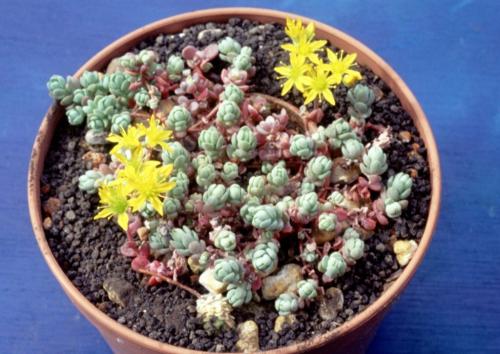DEBILE S. Watson, 1871
Synonyms :
Gormania debilis (S. Watson) Britton (1903) / Cotyledon debilis (S. Watson) Fedde (1904) / Echeveria debilis (S. Watson) A. Nelson & Macbride (1913) / Amerosedum debile (S. Watson) A. Löve & D. Löve (1985)
Distribution : Western USA (Great Basin, Central Rocky Mountains etc.), open places, 1500 - 3500 m.
Description (according to IHSP 2003) :
Glabrous perennial tufted herbs with slender decumbent fragile stems, propagating through axillary shoots forming compact almost globular rosettes.
Leaves decussate (rarely alternate), elliptic, sometimes ovate-elliptic, broadly rounded, sometimes weakly emarginate, minutely papillose at the tip, subterete, almost globular, sessile, clasping, 4,2 - 7,2 x 2,8 - 4,3 mm, pale glaucous-green, speckled with pink, sometimes pink or red.
Inflorescence : flowering branches erect, decumbent or ascending, 3 - 12 cm, Inflorescences cymes with 2 branches, bracts leaf-like but smaller, pedicels 0 - 1,2 mm.
Flowers 5-merous , sepals broadly sessile, basally connate, equal, lanceolate, obtuse, papillose, pale green and glaucous, ± 3,5 x 1,5 mm, erect, petals basally connate, elliptic-lanceolate, obtuse with a mucronate appendage, yellow, ± 7,5 mm, widely spreading above the erect bases, filaments yellow, anthers yellow.
Cytology : 2n=14 - 18
Ray Stephenson writes (Sedum, Cultivated Stonecrops, 1994, p. 196) : "The diminutive nature of this species with opposite-decussate leaves is the best guide to identification."
The tiny rosettes are similar in size to those of Sedum borschii.
